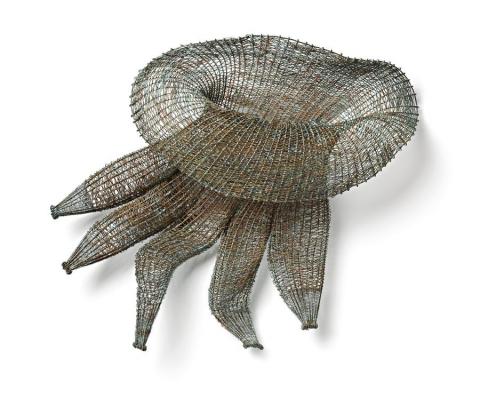COMET II, 1988
BRONWYN OLIVER
copper
80.0 x 90.0 x 30.0 cm
Roslyn Oxley9 Gallery, Sydney
Private collection, France
Bronwyn Oliver, Roslyn Oxley9 Gallery, Sydney, 1988
Bronwyn Oliver's sculptures are conundrums that belie the intensive process of their construction. The almost universal desire of the viewer is to touch the work; to seek confirmation of what we see, as though the gaze provides insufficient proof.
Characteristically exacting, Oliver's sculptures are taut with quiet energy, alluding to forms from the natural world. Closer inspection, however, reveals a dynamism that can only originate from the artificial. With a thoughtful sculptural sensibility, it is the 'delicate friction between surface and depth (that) breathes life into her objects: dense surfaces with translucent and vital interiors of air and light. Her objects are often sphere-like hollow spaces or openings - openings which lead to somewhere else, devolving from where they started.'1
Deeply seductive, the lithe copper forms for which Oliver became best known, and of which Comet II 1988 is a flawless example, are imbued with a classical, formal restraint. Like Comet, 1991 now held in the collection of the National Gallery of Australia, Canberra, there is an organic symmetry to the work which is instantly beguiling. We are reminded not only of the comet with its bifurcated tails of icy gas, but also the strange nebulae formations whose images are sent back to us through the Hubble Space Telescope.
As Oliver notes, 'When the ideas, the formal elements and the medium all work together a sculpture will 'sing' with a kind of rightness. It takes on a life, a presence, which is removed from this world. It belongs to a mythical other life, without a place in time.'2
1. Bullock, N., in Bond, T. and Tunnicliffe, T. (eds), Contemporary, Art Gallery of New SouthWales Contemporary Collection, Art Gallery of New South Wales, Sydney, 2006, p. 326
2. Sturgeon, G., Contemporary Australian sculpture, Craftsman House, Sydney, 1991, p. 74
MERRYN SCHRIEVER
